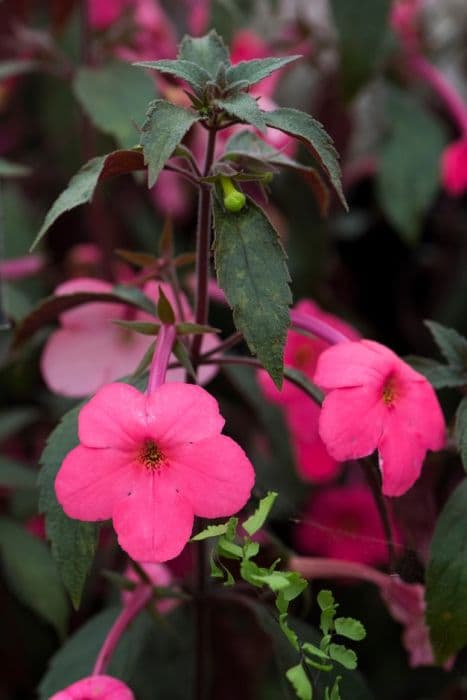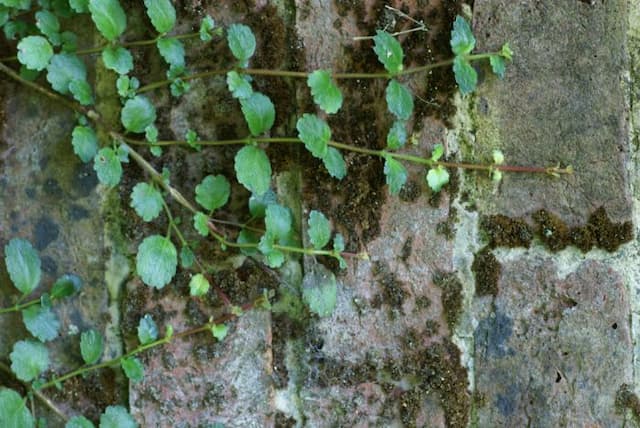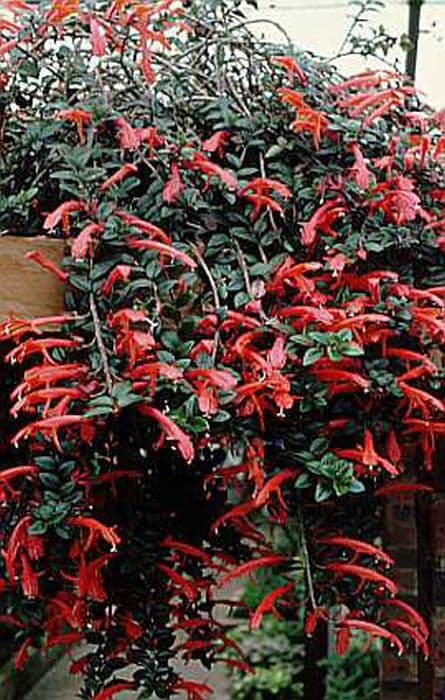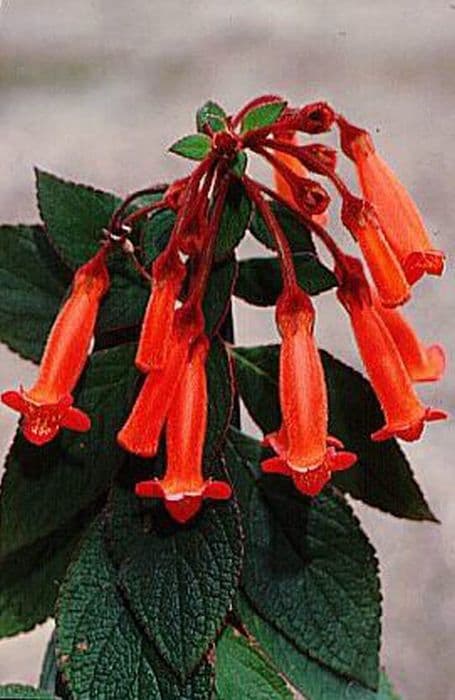Cape Primrose Streptocarpus 'Falling Stars'

ABOUT
The Streptocarpus 'Falling Stars', commonly known as Cape primrose, showcases a striking appearance defined by its lush foliage and captivating flowers. The plant displays a rosette of dark green, velvety leaves which provide a perfect backdrop for its floral display. Each leaf demonstrates a spear shape with a soft, sometimes slightly wrinkled texture, inviting the touch of a curious admirer. The flowers are the stars of the show, presenting themselves in a remarkable fashion that suggests a shower of stars falling from the night sky. These blossoms are typically tubular, flaring out into five distinct lobes at the mouth, and they boast an array of colors, often in enchanting shades of blue or purple, sometimes with throats of contrasting colors such as white or yellow. The delicate petals might be plain, bi-colored, or speckled, adding to the plant's charm and variety. Cape primrose flowers are borne on slender, arching stems, emerging from the center of the leaf rosette, and bloom profusely under the right conditions. The profusion of blooms often creates a cascading effect, enhancing the impression of a starry firmament. This floriferous nature makes the Cape primrose a beloved choice for indoor gardeners who wish to add a touch of celestial beauty to their surroundings. Overall, Cape primrose 'Falling Stars' can be characterized by its soft, inviting leaves and a spectacular explosion of star-like flowers that capture the imagination with their beauty and variety. Its dreamy presentation renders it a delightful specimen for anyone looking to bring a slice of the starlit sky into their home.
About this plant
 Names
NamesFamily
Gesneriaceae.
Synonyms
Cape Primrose, African Violet, Twisted Seedpod.
Common names
Streptocarpus 'Falling Stars'.
 Toxicity
ToxicityTo humans
The Cape Primrose (Streptocarpus 'Falling Stars') is generally not considered toxic to humans. If it were poisonous, common symptoms of plant poisoning can include nausea, vomiting, diarrhea, skin irritation, or allergic reactions, among others. However, the Cape Primrose does not typically pose any significant risk if ingested in small quantities. It's always wise to exercise caution and avoid eating plants not intended for consumption as individual sensitivity can vary.
To pets
The Cape Primrose (Streptocarpus 'Falling Stars') is generally considered non-toxic to pets. This means that if a pet ingests part of this plant, they are unlikely to experience serious symptoms of poisoning. However, it is still advisable to prevent pets from eating houseplants as they could cause mild digestive upset or an allergic reaction in some sensitive individuals. It's best to monitor pets and keep plants out of their reach to avoid any potential issues.
 Characteristics
CharacteristicsLife cycle
Perennials
Foliage type
Evergreen
Color of leaves
Green
Flower color
Mixed
Height
1 foot (30 cm)
Spread
1 foot (30 cm)
Plant type
Herb
Hardiness zones
10
Native area
Africa
Benefits
 General Benefits
General Benefits- Visual Interest: Streptocarpus 'Falling Stars', also known as Cape Primrose, adds aesthetic appeal to indoor environments with its attractive foliage and star-shaped flowers.
- Low Maintenance: Cape Primrose is known for being relatively easy to care for, requiring minimal maintenance, which is ideal for busy individuals or novice gardeners.
- Long Blooming Period: This plant offers a long flowering season, providing consistent color and interest in a home or office setting for extended periods.
- Compact Growth: With its modest growth habit, Cape Primrose is well-suited to smaller spaces, making it a good choice for apartments and compact living areas.
- Variety of Colors: The flowers of Cape Primrose come in a wide range of colors, allowing for customization and coordination with various interior design themes.
- Non-Toxicity: Cape Primrose is non-toxic, making it a safe choice for households with pets and children.
- Emotional Wellbeing: The presence of blooming plants like Cape Primrose can have a positive effect on mood and mental wellbeing, providing a sense of accomplishment and joy in cultivating living things.
- Gift Potential: Due to their beauty and ease of care, these plants make excellent gifts for plant enthusiasts or as a gesture of appreciation.
- Habitat Support: When grown outdoors in suitable climates, Cape Primrose can provide nectar for local pollinators, such as bees and butterflies.
- Educational: Caring for Cape Primrose can serve as an educational experience for children and adults alike, teaching the basics of botany and horticulture.
 Medical Properties
Medical PropertiesThis plant is not used for medical purposes.
 Air-purifying Qualities
Air-purifying QualitiesThis plant is not specifically known for air purifying qualities.
 Other Uses
Other Uses- Photography Subject: Due to its unique flowering pattern and vivid colors, Streptocarpus 'Falling Stars' can be an excellent subject for botanical photography, capturing the intricacies and beauty of its blooms.
- Educational Model: This plant can serve as a model organism in biology classes to demonstrate the lifecycle of angiosperms and the anatomy of flowering plants.
- Artistic Inspiration: Artists may use the aesthetic appeal of Streptocarpus 'Falling Stars' as inspiration for paintings, illustrations, and other forms of visual art.
- Color Therapy: The vibrant hues of the flowers can be used in color therapy, where colors are used to help balance energy in the body and promote wellbeing.
- Stamp Motif: The unique look of Streptocarpus 'Falling Stars' flowers can be featured on postage stamps, celebrating the diversity of flora in a region.
- Space Filler in Terrariums: Despite typically being a larger plant, smaller varieties of Streptocarpus can be used in terrariums to fill space and create a lush backdrop.
- Theme Events: The plant can be incorporated into event decor themes, such as garden parties or botanical weddings, providing a natural and elegant touch.
- Floral Arrangements: Whilst not a traditional cut flower, the blooms can occasionally be used in live floral arrangements when a unique or exotic look is desired.
- Fantasy Environments: Streptocarpus 'Falling Stars' can contribute to creating fantasy-themed environments or sets in theatrical productions due to their otherworldly appearance.
- Culinary Garnish: Although not commonly consumed, the petals of Streptocarpus 'Falling Stars', if proven safe, could be used to garnish desserts and cocktails for a decorative touch.
Interesting Facts
 Feng Shui
Feng ShuiThe Cape Primrose is not used in Feng Shui practice.
 Zodiac Sign Compitability
Zodiac Sign CompitabilityThe Cape Primrose is not used in astrology practice.
 Plant Symbolism
Plant Symbolism- Resilience: Streptocarpus, commonly known as Cape Primrose, often symbolizes resilience as they can bloom for a long period and can thrive with minimal care.
- Endurance: The long-lasting nature of their blooms is often viewed as a symbol of enduring through challenges and hardships.
- Hope: With their bright and persistent flowers, Cape Primrose is sometimes seen as a symbol of hope and positive expectations for the future.
- Rarity: Given their unique appearance and less common occurrence, they can symbolize uniqueness or rarity in the world of plants.
- New Beginnings: As Cape Primrose can easily be propagated and started anew from leaf cuttings, they may represent new beginnings or starting over.
 Water
WaterCape primrose needs consistent moisture but does not like to sit in water, so it’s important to water it when the top inch of soil feels dry. Water the plant thoroughly, allowing water to drain out of the bottom of the pot; this may be roughly every 5 to 7 days depending on the humidity and temperature of your home. Be cautious not to water directly into the crown of the plant as this can promote rot. Use tepid water and aim to provide about 8 to 16 oz per week, adjusting as needed for environmental factors. Overwatering can be detrimental, so ensure the plant is never left in standing water.
 Light
LightCape primrose prefers bright, indirect sunlight. It thrives in east- or west-facing windows where it receives some gentle morning or evening sun. However, it's crucial to avoid harsh direct sunlight, especially during the hot afternoon hours, as this can scorch the leaves and bloom. A spot with dappled light or a location where sunlight is filtered through a sheer curtain can be ideal.
 Temperature
TemperatureCape primrose thrives in temperatures between 60°F and 75°F, which are typical indoor temperatures. It can tolerate temperatures as low as 50°F, but growth will slow down. Ensure that the plant is kept away from drafts, cold windows, and heat sources which can cause fluctuations in temperature. Consistency is key to keeping your Streptocarpus 'Falling Stars' happy.
 Pruning
PruningPruning Cape primrose is generally done to remove dead or yellowing leaves and faded flowers to promote a tidy appearance and encourage further blooms. This can be done as needed throughout the year. It's best to prune just above the base of the leaf stem using clean, sharp scissors. After the main blooming period, you can cut back the flower stalks to stimulate new growth.
 Cleaning
CleaningAs needed
 Soil
SoilCape Primrose, Streptocarpus 'Falling Stars', prefers a well-draining potting mix with high organic content such as a blend of peat moss, perlite, and vermiculite. The ideal soil pH for Cape Primrose is slightly acidic to neutral, ranging from 6.0 to 7.0.
 Repotting
RepottingCape Primrose should be repotted every 1-2 years to refresh the soil and provide room for growth. Spring is the best time for repotting.
 Humidity & Misting
Humidity & MistingCape Primrose thrives at moderate to high humidity levels, ideally between 50% and 70%. Avoid placing in low humidity environments.
 Suitable locations
Suitable locationsIndoor
Place Cape Primrose in bright, indirect light and keep soil moist.
Outdoor
Shelter Cape Primrose from strong sun; keep in a semi-shaded spot.
Hardiness zone
Cape Primrose is suitable for 10-11 USDA.
 Life cycle
Life cycleStreptocarpus 'Falling Stars', commonly known as Cape primrose, begins its life cycle when a seed germinates, usually in warm, moist soil, developing into a small seedling with a few leaves. As it matures, the plant forms a rosette of dark green leaves and, given the right conditions of indirect light and high humidity, will grow larger and start producing long, delicate flower stems. The flowers, often characterized by vivid colors and intricate patterns, bloom in a succession over a period of several months. After pollination, which can happen naturally or be assisted by gardeners, the flowers will fade and seed pods may develop. These seed pods ripen, eventually releasing seeds to start a new generation. Throughout its life span, which can be several years in favorable indoor conditions, a Cape primrose may enter into periods of dormancy, where growth slows or pauses, especially in cooler or drier times of the year.
 Propogation
PropogationPropogation time
Spring to Summer
Propogation: Propagating the Streptocarpus 'Falling Stars', commonly known as Cape Primrose, is most commonly done through leaf cuttings. It is best undertaken during the warm months of spring through early summer when the plant is actively growing. A robust, healthy leaf is chosen and a horizontal cut made across the leaf, preferably through the main vein. This section of the leaf is then placed flat onto moist potting mix, pressing gently to ensure contact with the soil. The pot is typically covered with a clear plastic bag or placed in a propagator to ensure high humidity and kept in a warm place out of direct sunlight. Roots and new shoots should develop from the cut edge or vein within a few weeks, indicating successful propagation. Once these shoots have grown large enough to handle, they can be separated gently and potted up as new plants.









